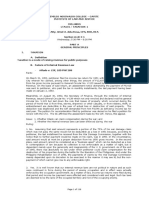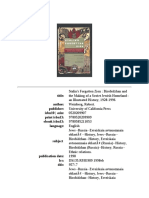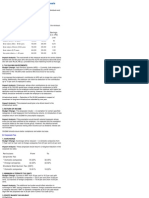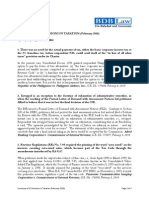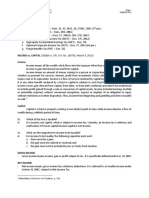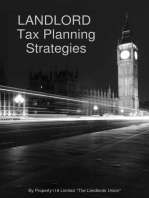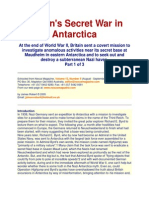Legislative Background
Legislative Background
Uploaded by
api-167940199Copyright:
Available Formats
Legislative Background
Legislative Background
Uploaded by
api-167940199Original Title
Copyright
Available Formats
Share this document
Did you find this document useful?
Is this content inappropriate?
Copyright:
Available Formats
Legislative Background
Legislative Background
Uploaded by
api-167940199Copyright:
Available Formats
Craig
- SCC Allows Lawyer Unrestricted Farm Loss Deduction Canadian Tax Adviser - http://preview.tinyurl.com/KPMG-SCC-Craig August 07, 2012 The Supreme Court of Canada (SCC) has found in favour of the taxpayer on the correct application of the restricted farm loss rules in section 31 of the Act in The Queen v. John H. Craig. In this unanimous decision, the SCC overturned its position in Moldowan, which was decided in 1978. The SCC essentially agrees with the Tax Court of Canada's (TCC) and the Federal Court of Appeal's (FCA) earlier decisions in Craig that the taxpayer, who was a lawyer and ran a law practice, could deduct losses he incurred from his horse-racing business without restriction against all sources of income, consistent with the FCA decision in Gunn. As a result, the taxpayer was able to deduct farming losses of approximately $428,000 against his income in 2000 and 2001, rather than being restricted to losses of only $17,500 ($8,750 per year) under section 31 of the Act. Legislative background When a taxpayer carries on a farming business (i.e., the taxpayer has a reasonable expectation of profit for that business), but the taxpayer's chief source of income is not derived from farming or a combination of farming and some other source of income (the "combination test"), subsection 31(1) of the Act restricts the taxpayer's deductibility of losses from farming against other sources of income. The maximum allowable annual deduction for a farm loss is restricted by a formula in subsection 31(1) to $8,750. Any unclaimed farm loss is considered a "restricted farm loss" under subsection 31(1.1) of the Act and is available for carryover. In Moldowan, a landmark restricted farm loss case, the SCC classified a taxpayer for which "farming may reasonably be expected to provide the bulk of income or the centre of work routine" as one whose farm losses would not be restricted for tax purposes. In Gunn v. Canada, the FCA considered the "combination test" and concluded that it is not necessary for a farmer with a combined source of income activities to have farming as the predominate source. The FCA said that this view would "avoid the judge-made test that requires farming to be the predominant element in the combination of farming with the second source of income...". Facts In this case, the taxpayer (Mr. C) received his primary source of income from his law practice. He also had income from investments, stock options and farming (buying, selling, training and maintaining horses for racing). From 1986 to 2008, Mr. C experienced farm losses in 16 out of the 22 tax years. He deducted these losses from the horseracing business from his other income. Based on Moldowan, the CRA reassessed Mr. C to restrict his farming losses of
approximately $428,000 for his 2000 and 2001 taxation years to $17,500 ($8,750 per year) on the grounds that the combination of the law practice and the horseracing business was not Mr. C's chief source of income. The remaining unclaimed farm losses of $410,500 ($428,000 less $17,500) were assessed by the CRA to be "restricted farm losses" that could only be deducted against future farming income. Lower court decisions Following the FCA's earlier decision in Gunn, which conflicted with the Moldowan interpretation of the "combination question", the TCC allowed Mr. C's appeal (2009 TCC 617), finding that the loss deduction limitation in subsection 31(1) did not apply. The FCA dismissed the CRA's appeal (2011 FCA 22) on the basis that it was required to follow its prior decision in Gunn. SCC decision The SCC concluded that the Moldowan approach to the "combination question" related to chief sources of income is incorrect, and it revisited the interpretation of section 31, which provides for two distinct exceptions to the loss deduction limitation under subsection 31(1). The SCC noted that a judge-made rule that reads one of these exceptions "out of the provision cannot stand". Taking a contextual approach, the following relevant factors should be considered when interpreting section 31: The capital invested in farming and the second source of income The income from each of the two sources of income The time spent on the two sources of income The taxpayer's ordinary mode of living, farming history, and future intentions and expectations. If these factors tend to show that the taxpayer places a significant emphasis on both his farming and non-farming sources of income, such a combination should constitute a chief source of income and avoid the application of the loss deduction limitation of subsection 31(1). While both endeavours must be significant to the taxpayer, they do not need to be connected, and farming does not need to be the predominant source of income. The SCC noted that this determination is a factual one, and must be flexible, recognizing that not each factor need be significant. Such an interpretation is consistent with the general policy of the Income Tax Act that allows taxpayers to generally offset losses from one business or source of income against profits from another without limitation. As a result of its analysis, the SCC dismissed the CRA's appeal. Therefore, Mr. C was able to deduct $428,000 (rather than $17,500) of farming losses against other income he earned in 2000 and 2001.
You might also like
- TAX 1 SYLLABUS - GoldDocument116 pagesTAX 1 SYLLABUS - Golddennis buclanNo ratings yet
- Paul Sabin, "The Bet: Paul Ehrlich, Julian Simon, and Our Gamble Over Earth's Future," (Yale University Press, 2013, Excerpt)Document12 pagesPaul Sabin, "The Bet: Paul Ehrlich, Julian Simon, and Our Gamble Over Earth's Future," (Yale University Press, 2013, Excerpt)psabin123100% (1)
- Powers & Limitations of The Judiciary Step 1: Can/will The Supreme Court Hear The Case?Document1 pagePowers & Limitations of The Judiciary Step 1: Can/will The Supreme Court Hear The Case?Brat WurstNo ratings yet
- WTO Dispute Settlement Mechanism: A Critical AnalysisDocument19 pagesWTO Dispute Settlement Mechanism: A Critical AnalysisBalaji P Nadar100% (5)
- Stalins Forgotten Zion Birobidzhan and The Making of A Soviet Jewish Homeland An Illustrated History, 1928-1996 by Robert WeinbergDocument226 pagesStalins Forgotten Zion Birobidzhan and The Making of A Soviet Jewish Homeland An Illustrated History, 1928-1996 by Robert WeinbergALONSO EMILIO CASTILLO FLORES100% (1)
- Tax ReviewerDocument132 pagesTax ReviewerMelNo ratings yet
- LOA - s4681214 - Taxation Law and PracticeDocument12 pagesLOA - s4681214 - Taxation Law and PracticeJayodya MallikarachchiNo ratings yet
- Atlas Consolidated Mining Co. v. CIR, G.R. No. L-20911, January 27, 1981 - Full TextDocument9 pagesAtlas Consolidated Mining Co. v. CIR, G.R. No. L-20911, January 27, 1981 - Full TextNewbie KyoNo ratings yet
- Today Is Monday, October 12, 2020Document11 pagesToday Is Monday, October 12, 2020sbce14No ratings yet
- Helvering v. Bliss, 293 U.S. 144 (1934)Document6 pagesHelvering v. Bliss, 293 U.S. 144 (1934)Scribd Government DocsNo ratings yet
- Republic of The Philippines Court of Tax Appeals Quezon CityDocument16 pagesRepublic of The Philippines Court of Tax Appeals Quezon CitySarah Elaiza BuycoNo ratings yet
- Cir v. ST Luke's Medical Center Inc. GR No. 195909Document11 pagesCir v. ST Luke's Medical Center Inc. GR No. 195909Joshua RodriguezNo ratings yet
- Er 1-94Document5 pagesEr 1-94Krizia ReamicoNo ratings yet
- Taxation 2015 CasesDocument21 pagesTaxation 2015 CasesErika Mae GumabolNo ratings yet
- Tax Cases ConsolidatedDocument64 pagesTax Cases ConsolidatedJesse Myl MarciaNo ratings yet
- 60-Acmdc v. Cir G.R. No. L-26911 January 27, 1981Document8 pages60-Acmdc v. Cir G.R. No. L-26911 January 27, 1981Jopan SJNo ratings yet
- SLB Tax Pre Week Material 2018 Bar 11072018Document15 pagesSLB Tax Pre Week Material 2018 Bar 11072018Jade LorenzoNo ratings yet
- Possibilities in Taxation For 2016 Mock Bar and Beyond - Atty. Roberto Bobby LockDocument74 pagesPossibilities in Taxation For 2016 Mock Bar and Beyond - Atty. Roberto Bobby LockHilikus IncubusNo ratings yet
- Cir vs. St. Luke Medical CenterDocument23 pagesCir vs. St. Luke Medical CenterRoland ApareceNo ratings yet
- Agriculture Law: RS20564Document4 pagesAgriculture Law: RS20564AgricultureCaseLawNo ratings yet
- TAX II Case 21 30Document27 pagesTAX II Case 21 30Raymarc Elizer AsuncionNo ratings yet
- Inland Revenue Dept.Document67 pagesInland Revenue Dept.ForkLogNo ratings yet
- Republic vs. Heirs of JalandoniDocument18 pagesRepublic vs. Heirs of JalandoniJose Emmanuel DolorNo ratings yet
- Atty. Lock - Updates and Critical Areas in Taxation (2018 Bar Legal Edge) PDFDocument205 pagesAtty. Lock - Updates and Critical Areas in Taxation (2018 Bar Legal Edge) PDFTraviNo ratings yet
- Hobby Loss LetterDocument5 pagesHobby Loss LetterLisa SclanNo ratings yet
- Preweek Taxation Law Atty. William Benson S. GanDocument207 pagesPreweek Taxation Law Atty. William Benson S. Ganjamillabercedes24No ratings yet
- PAGCOR PetitionDocument5 pagesPAGCOR PetitionRuzevie GuintoNo ratings yet
- Taxation (Income Tax) - Pp41-60Document37 pagesTaxation (Income Tax) - Pp41-60Iya PadernaNo ratings yet
- United States v. Public Service Company of Oklahoma, 241 F.2d 18, 10th Cir. (1957)Document4 pagesUnited States v. Public Service Company of Oklahoma, 241 F.2d 18, 10th Cir. (1957)Scribd Government DocsNo ratings yet
- Decision: Republic of The Philippines Court of Tax Appeals Quezon CityDocument10 pagesDecision: Republic of The Philippines Court of Tax Appeals Quezon CityJenMarlon Corpuz AquinoNo ratings yet
- 04 Taxation-Law-Suggested-Answer-2019 - BRI98Document20 pages04 Taxation-Law-Suggested-Answer-2019 - BRI98Margarita AvilaNo ratings yet
- Dumaguete Cathedral Credit Cooperative VDocument7 pagesDumaguete Cathedral Credit Cooperative VJihan LlamesNo ratings yet
- CTA_2D_CV_10501_D_2024MAY03_REF Global EnergyDocument28 pagesCTA_2D_CV_10501_D_2024MAY03_REF Global EnergyVince Lupango (imistervince)No ratings yet
- Australian TaxationDocument45 pagesAustralian TaxationEhtesham HaqueNo ratings yet
- I. TaxationDocument113 pagesI. Taxationdennis buclanNo ratings yet
- Category Current (RS) Proposed (RS) Savings P.A. (RS) : Direct TaxDocument16 pagesCategory Current (RS) Proposed (RS) Savings P.A. (RS) : Direct TaxshwetakuppanNo ratings yet
- By: Bryan Joseph L. Mallillin: G.R. No. 179800, February 4, 2010Document3 pagesBy: Bryan Joseph L. Mallillin: G.R. No. 179800, February 4, 2010Marivic SorianoNo ratings yet
- Atlas Consolidated Mining - Devt Corp. Vs CIR GR No. L-26911-January 27, 1981Document3 pagesAtlas Consolidated Mining - Devt Corp. Vs CIR GR No. L-26911-January 27, 1981Nathalie YapNo ratings yet
- Cta 2D CV 09296 A 2020jan02 Ass PDFDocument20 pagesCta 2D CV 09296 A 2020jan02 Ass PDFAnnaNo ratings yet
- Office of The Solicitor General For Petitioner. Hilado and Hilado For RespondentDocument11 pagesOffice of The Solicitor General For Petitioner. Hilado and Hilado For RespondentellaNo ratings yet
- Office of The Solicitor General For Petitioner. Hilado and Hilado For RespondentDocument11 pagesOffice of The Solicitor General For Petitioner. Hilado and Hilado For RespondentellaNo ratings yet
- 2019 To 2015 TAX BAR Q ADocument87 pages2019 To 2015 TAX BAR Q AJade Ligan EliabNo ratings yet
- July 18 - SPIT NotesDocument8 pagesJuly 18 - SPIT NotesMiggy CardenasNo ratings yet
- TAX Digest 3Document2 pagesTAX Digest 3Barrymore Llegado Antonis IINo ratings yet
- Possibilities in Taxation For The 2017 Bar Examinations: (Project Phoenix)Document54 pagesPossibilities in Taxation For The 2017 Bar Examinations: (Project Phoenix)Ihon BaldadoNo ratings yet
- TAX - 4 - CONWI v. CTADocument1 pageTAX - 4 - CONWI v. CTAMokeeCodilla100% (1)
- Tax Management Association of The Philippines, Inc.Document15 pagesTax Management Association of The Philippines, Inc.marjNo ratings yet
- Erroneous Foreign Earned Income Exclusion ClaimsDocument40 pagesErroneous Foreign Earned Income Exclusion ClaimstaxesforexpatsNo ratings yet
- Canadite ComparisonDocument42 pagesCanadite Comparisonds92jzNo ratings yet
- MonthlySnapshot July Final-2Document25 pagesMonthlySnapshot July Final-2shreyanshogreymba2024No ratings yet
- CREBA vs. RomuloDocument29 pagesCREBA vs. RomuloCharish DanaoNo ratings yet
- Kinds of Income TaxesDocument9 pagesKinds of Income TaxesRon RamosNo ratings yet
- CIR v. CA, 207 SCRA 487 (1992) PDFDocument5 pagesCIR v. CA, 207 SCRA 487 (1992) PDFsbce14No ratings yet
- 2010 Taxation Law Bar Examination QuestionsDocument5 pages2010 Taxation Law Bar Examination QuestionsMowan100% (1)
- 020 Island Power Corp V CirDocument2 pages020 Island Power Corp V CirNorman ManaloNo ratings yet
- CIR vs. Mirant DigestDocument2 pagesCIR vs. Mirant DigestAldrin Tang100% (2)
- CIR Vs PALDocument1 pageCIR Vs PALBrylle Garnet DanielNo ratings yet
- Cta 00 CV 06470 D 2004jan23 RefDocument10 pagesCta 00 CV 06470 D 2004jan23 RefcehsscehlNo ratings yet
- Comments On Tax Laws (Second Amendment) Act, 2021Document15 pagesComments On Tax Laws (Second Amendment) Act, 2021Abubakar IsmailNo ratings yet
- Exhibit 11BDocument25 pagesExhibit 11BOSDocs2012No ratings yet
- Cta 00 CV 06189 D 2002apr04 AssDocument12 pagesCta 00 CV 06189 D 2002apr04 AssesiribanNo ratings yet
- General Electric Credit Corporation v. Strickle Properties, Ray Lyle and T.P. Strickland, 861 F.2d 1532, 11th Cir. (1988)Document8 pagesGeneral Electric Credit Corporation v. Strickle Properties, Ray Lyle and T.P. Strickland, 861 F.2d 1532, 11th Cir. (1988)Scribd Government DocsNo ratings yet
- Canadian Securities Administrators Consultation Paper 25-401: Potential Regulation of Proxy Advisory FirmsDocument3 pagesCanadian Securities Administrators Consultation Paper 25-401: Potential Regulation of Proxy Advisory Firmsapi-167940199No ratings yet
- Director Removal: A Five-Point Plan: Richard LeblancDocument2 pagesDirector Removal: A Five-Point Plan: Richard Leblancapi-167940199No ratings yet
- Sunset Cove Mining Discovers 13 New Silver Veins To Be Drilled ShortlyDocument5 pagesSunset Cove Mining Discovers 13 New Silver Veins To Be Drilled Shortlyapi-167940199No ratings yet
- UntitledDocument25 pagesUntitledapi-167940199No ratings yet
- IS141Document4 pagesIS141Cesar Corredor ColmenaresNo ratings yet
- Legislative Studies PDFDocument614 pagesLegislative Studies PDFMaksym Kopylov100% (5)
- Social Work and Elder Abuse: A Foucauldian Analysis: Jason L. Powell, University of LiverpoolDocument10 pagesSocial Work and Elder Abuse: A Foucauldian Analysis: Jason L. Powell, University of LiverpoolJorge PlanoNo ratings yet
- United States Interventions: by John H. CoatsworthDocument3 pagesUnited States Interventions: by John H. CoatsworthAlfredo Botina CruzNo ratings yet
- Nuclear Law International Law546Document1 pageNuclear Law International Law546kingNo ratings yet
- Vikram UniversityDocument6 pagesVikram UniversityPapri Roy DasguptaNo ratings yet
- Rights-Based Programming TotchDocument40 pagesRights-Based Programming TotchTotch Dela CruzNo ratings yet
- Form GST REG-06: (Amended)Document3 pagesForm GST REG-06: (Amended)Aprajita SharmaNo ratings yet
- UK Education Seminar - MPW and Fregoman SeminarDocument5 pagesUK Education Seminar - MPW and Fregoman SeminarGordon LamNo ratings yet
- Review of Related Literature PR2Document2 pagesReview of Related Literature PR2apple clerionNo ratings yet
- KAS SyllabusDocument11 pagesKAS Syllabushemanth kumar m100% (1)
- Pinoy Law Blog - San Beda Commercial Law ReviewerDocument3 pagesPinoy Law Blog - San Beda Commercial Law ReviewerGil EnriquezNo ratings yet
- Verceles vs. Bureau of Labor RelationsDocument2 pagesVerceles vs. Bureau of Labor RelationsKathlene JaoNo ratings yet
- Judgment For The Plaintiff - Capital One Bank vs. Mitchell Lee SorensenDocument20 pagesJudgment For The Plaintiff - Capital One Bank vs. Mitchell Lee SorensenthesacnewsNo ratings yet
- Sustainable Development Goals (SDGS) : "Achieve Gender Equality and Empower All Women and Girls."Document3 pagesSustainable Development Goals (SDGS) : "Achieve Gender Equality and Empower All Women and Girls."Peter Odosamase OsifoNo ratings yet
- Britain War in AntarcticaDocument34 pagesBritain War in Antarcticamanetti2007100% (2)
- Millennial Capitalism and The Culture of NeoliberalismDocument335 pagesMillennial Capitalism and The Culture of Neoliberalismsinisterginger100% (1)
- RPH Finals ReviewerDocument7 pagesRPH Finals Reviewermaranan.davidjeffersonr.kldNo ratings yet
- Robert Lambert MBE "Rebuilding Trust"Document2 pagesRobert Lambert MBE "Rebuilding Trust"BristleKRSNo ratings yet
- 100% INSTANT RESULTS SPELLS CASTER +256779317397, Love, Marriage, Divorce & Fertility SpellsDocument2 pages100% INSTANT RESULTS SPELLS CASTER +256779317397, Love, Marriage, Divorce & Fertility SpellsProf MuuzaNo ratings yet
- Thinking Like A LawyerDocument8 pagesThinking Like A Lawyerjobert cortezNo ratings yet
- Daily Bellwether - Comments Re: Cincinnati Beacon, 6-13-08Document2 pagesDaily Bellwether - Comments Re: Cincinnati Beacon, 6-13-08cincinnati.beaconNo ratings yet
- Weeknieuws Pro Bista Week 39Document2 pagesWeeknieuws Pro Bista Week 39Michel MotshagenNo ratings yet
- Download Full American government in Black and White: diversity and democracy Third Edition Mcclain PDF All ChaptersDocument41 pagesDownload Full American government in Black and White: diversity and democracy Third Edition Mcclain PDF All Chapterscowlenunes1k100% (2)
- Western Sahara Advisory OpinionDocument7 pagesWestern Sahara Advisory OpinionJessica Bernardo100% (1)
- EVS Sample Paper-3Document5 pagesEVS Sample Paper-3seeja bijuNo ratings yet
